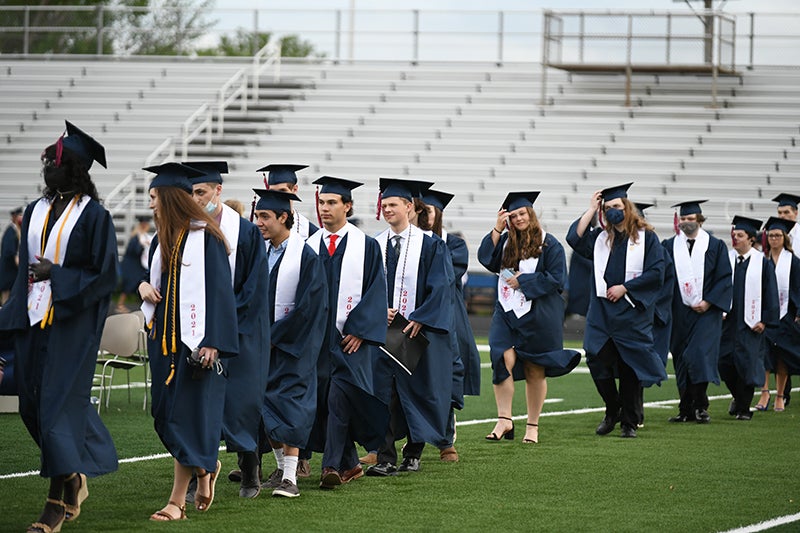State, Albert Lea school district, most area schools see decline in four-year graduation rates last year
Published 6:54 pm Friday, April 1, 2022

- The graduating class makes their way to the front of the stage before the 2021 commencement ceremony. Tyler Julson/Albert Lea Tribune
|
Getting your Trinity Audio player ready...
|
Four-year graduation rates fell slightly from 2020 to 2021 across the state, and Albert Lea Area Schools were no exception.
Of the 272 students between the two Albert Lea secondary schools in 2020, 80.88% of all students graduated in four years, while of the 259 students who attended last year, 71.81% of all students graduated in four years, a 9.7% fall in the four-year graduation rate.
The graduation rate at Albert Lea High School after four years was 85.57%, a decline from 85.78% in 2020. In 2021, the graduation rate improved to 88.78% after five years and 91.13% after six years. And after seven years, the graduation rate was at 91.78%.
Among other declining numbers were graduation rates among whites, English learners, special education students and students who qualified for free or reduced-price meals.
Students who identified as Asian increased their rate of graduation by 5.56% from 83.33% in 2020 to 88.89% last year. Hispanics also graduated in four years at a slightly higher rate: 79.49% (2020) to 80% (2021).
Graduation rates among four-year students at the Albert Lea Area Learning Center were particularly impacted, with graduation rates falling 33.16% among all students from 63.93% in 2020 to 30.77% last year. In 2020, the number of students graduating in five years dipped to 57.78%, but almost 68.33% percent of students at the learning center graduated in six years. The rolling trend continued, 63.9% of students graduated in seven years.
In 2021, 76.47% graduated in five years, 59.27% in six years and 73.08% in seven years.
Hispanic student graduation fell from 47.73% to 27.27%, white student graduation dipped from 62.16% to 28.57% and graduation among students eligible for free/reduced-price meals dipped from 60.78% to 32.08%. Special education graduation fell from 68.75% to 41.18%, but that 27.57% fall in four-year graduation rates was the lowest dip among different student groups at the learning center.
By comparison, Alden-Conger, New Richland-Hartland-Emmons-Glenville and Glenville-Emmons schools also saw a decrease in the rate of four-year graduation, Alden-Conger at 6.53%, NRHEG at 5.24% and Glenville-Emmons at 13.54%.
United South Central, on the other hand, boosted its four-year graduation rate from 85.71% to 88.89%, an increase of 3.18%.
Minnesota experienced a .5% drop from 2020 in its four-year rates, reflecting the role the pandemic played over the last two years, according to a recent press release from the Minnesota Department of Education. In last year’s class, 57,137 students graduated in four years, an 83.3% rate.
The decrease was driven by a .3% increase in student dropout, while the other .2% point decrease in graduation rate was unaccounted for.
In the state of Minnesota last year, 3,594 students from earlier classes earned diplomas and graduated in five, six or seven years after starting high school.
The decreased graduation rate is in contrast to previous years, where the state’s four-year graduation rate had been increasing from 82.5% (2016) to 83.8% (2020). Dropout rates had also been falling.
What makes last year’s class unique is that it was the first class who experienced a full school year under the COVID-19 pandemic.
“The class of 2021 faced incredibly difficult circumstances in their final years of high school,” said Heather Mueller, the state’s commissioner of education, in a press release.
According to the release, the dip underscores the necessity of keeping public schools funded and resources available for all students.
New to the graduation report was Minnesota’s definition of American Indian. That definition allowed students to be reported as such even if they belonged to other racial/ethnic groups. Under the federal definition of American Indian or Alaska native, students would have fallen under the categories of Hispanic/Latino or two or more races, and as such wouldn’t have counted as American Indian or Alaska Native.
The four-year graduation rate for American Indian saw an increase in graduation from 58.4% to 58.5% between 2020 and 2021.
Besides American Indian students, other student groups that increased their four-year graduation rates from 2020 to 2021 included black students (+1.2%) and those who identified as two or more races (+1.1%).
Groups that saw decreases in four-year graduation rates included English learners (-1.5%) and students who received special education services (-1%)
“I am extremely proud of our 2021 graduates and the educators, leaders, staff and families who helped them make it to graduation,” Mueller said.




